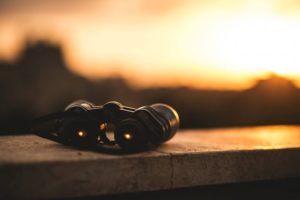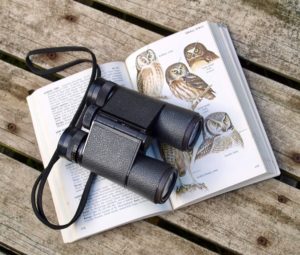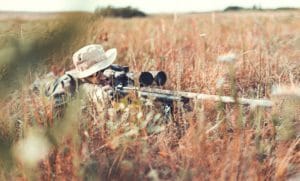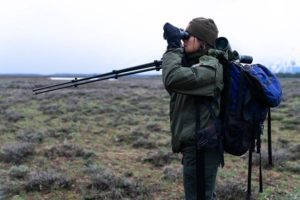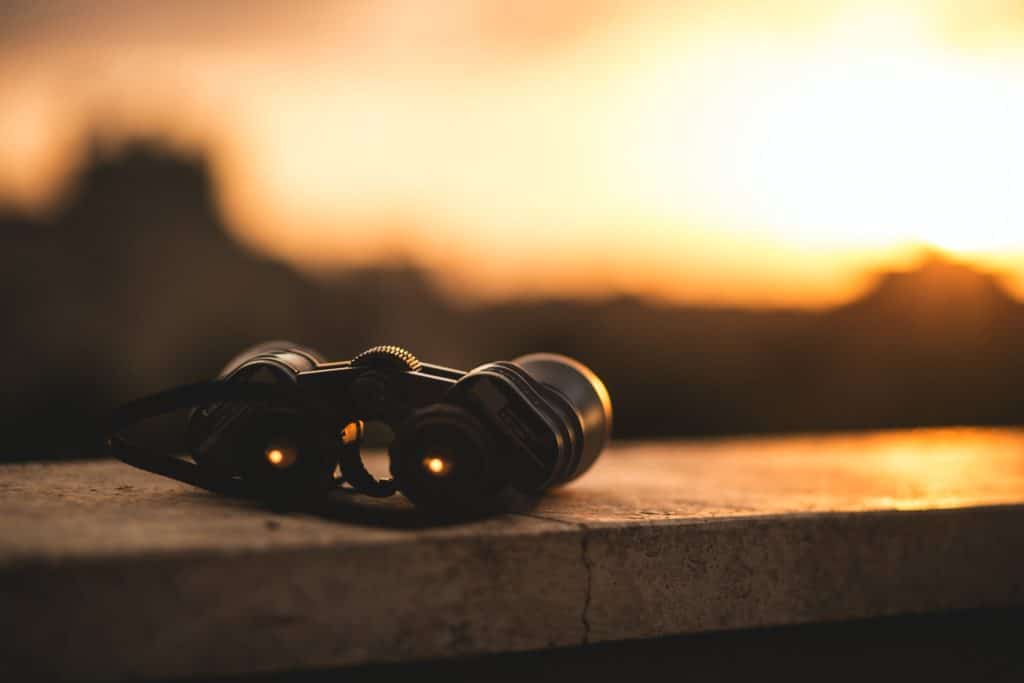Since their inception, compact binoculars have increasingly become popular. Whether you’re bird watching, sightseeing, star gazing, watching your favorite horse on the racetrack, or even game hunting, lightweight binoculars are certainly must-have gadgets.
However, with the availability of various models with varying specifications, it’s easy to get confused about which one would be the best compact binoculars for travel.
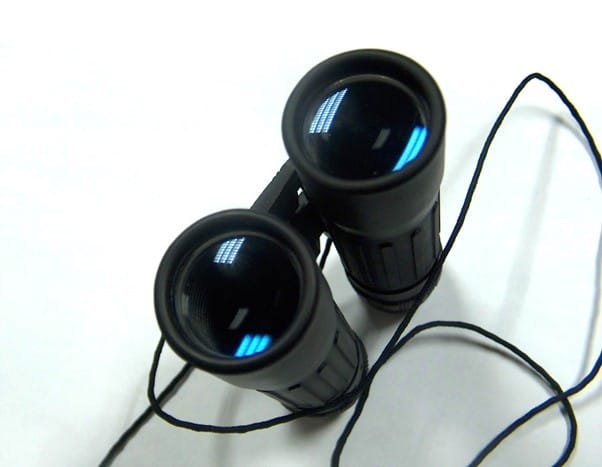
Additionally, how certain binoculars work, what makes one pair better for certain situations than another, and the various numeric specifications may pose a challenge to understand.
Luckily, this article sheds light on the above-mentioned factors and provides a list of the best recommendations, with Nikon Trailblazer ATB 10×25 Binocular being our overall pick for the best lightweight binoculars for travel.
If you want to go straight to the products, here’s the list of our top recommendations of the Best Lightweight Binoculars for Travel.
- Nikon Trailblazer ATB 10x25 Binocular Best Overall
- Bushnell H20 8X25 Waterproof Roof Prism Binocular First Runner’s Up
- Olympus WP II 8x25 Binocular Best Viewing Experience
- Nikon Aculon T02 Binoculars Best for Portability
- Minox X-Lite 8×26 Binoculars for Outdoor Activities Best Build Quality
Types of Binoculars
There are generally two types of binoculars: Porro prism design and roof prism binocular. The difference between the two lies in the way the prisms pass light to your eyes through the binoculars. You can also differentiate the two types of binoculars by their shapes.

Porro Prism Binoculars
Porro prism design binoculars are such that the eyepiece and the lenses aren’t on the same line. They have a conventional M-shaped design and a tool in the middle of the binoculars used to adjust the position of the tubes.
These binoculars are superior to roof prisms in terms of magnification and provide a better depth of field and a wider field of view. However, they are heavy to carry around and may not be favorable for long excursion trips.
Roof Prism Binoculars
The lenses and the eyepiece of these binoculars are on the same line. Unlike Porro prism binoculars, roof prisms have a modern-looking H-shape design.
Binoculars with roof prisms have thinner optical tubes, making them easy to hold Additionally, they are lightweight and compact, an excellent feature for binoculars you intend to use for extended periods.
However, what roof prisms make up for in weight and portability, they lack in magnification. It’s also crucial to note that they are also a tad pricier than Porro prisms.
Factors to Consider When Choosing the Best Compact Binoculars for Travel
Suppose you find numerous compact and lightweight binoculars. How do you choose one over the other? This section highlights essential factors to consider.
Field of View (FOV)
The field of view is the width of the visible area you can see on the horizontal plane at 1000 yards, while keeping the binoculars stationary at minimum magnification.
The field of view decreases as the magnification increases.
The size of the FOV’s importance may be dependent on what you want the binoculars for.
If you are using them to see sights up close, a wide FOV is less important than a good zoom. If you want to track wildlife or game, a wide FOV would be more desirable.
Binocular Magnification Numbers
Have you ever wondered what the digits indicated on the side of binoculars mean, say 10×50? The first digit (10) refers to the binocular magnification, while the second is the objective lens diameter.
The first digit(s) tells you how many times the binoculars will magnify an object. For instance, a 10x magnification means that the subject will appear ten times closer to you than with the human eye.
The second number shows how large the lens is. The bigger the lens diameter, the more light transmission will occur, resulting in bright clear images.
Binoculars with an objective lens greater than 30mm are considered standard, whereas those less than 30mm are considered compact. If you’re going on a safari, you should consider a pair with a broad field of view and a magnification of 7x or 8x.
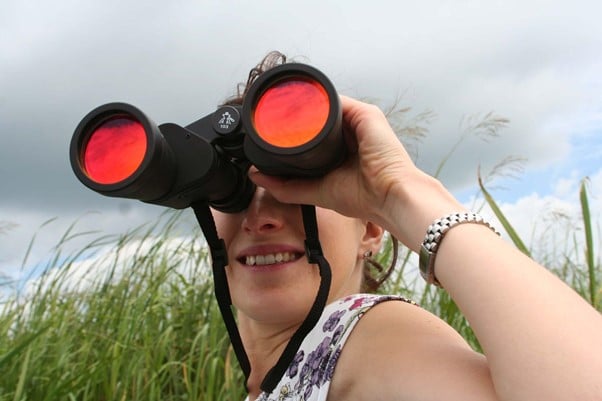
Waterproof Feature
If you enjoy boating, birdwatching, and other outdoor adventures, you should consider getting waterproof binoculars to prevent water from getting in and damaging the interior of your binoculars. This means that the binoculars have O rings that prevent moisture from reaching the inside of your binoculars.
Additionally, some travel binoculars are designed such that when exposed to moisture, they can remain damage-free. Go for travel binoculars with DIN (German Institute for Standardization) or JIN (Japanese Industrial Standards) ratings to show the binocular’s waterproof rating.
Waterproof travel binoculars can withstand rainwater but cannot handle full submersion. This means that if your binoculars fall in the water, you should pick them up as soon as possible.
Binoculars certified as weatherproof can withstand a higher level of water splashing or heavy rain. However, despite the waterproof rating, it is important to note that binoculars may eventually start leaking under prolonged exposure to elements. Always wipe off any moisture from the binoculars before storing them.
Fog-Proof Feature
Compact binoculars filled with inert gases such as Nitrogen or Argon offer a fog-free view and enhanced durability. Travel binoculars become foggy when the air inside the binocular’s optical housing contains moisture.
The moisture is trapped in the optical tubes and promotes fungus growth, eventually rendering the pair of binoculars useless.
When a pair of binoculars is rated as fog proof, it means that they have been filled with Nitrogen, Argon, or both. Fog proofing works by pumping the inert gas under high pressure into the optical tubes. Such binoculars are best suited for bird or animal watchers that occasionally get caught up in wet conditions.
Eye Relief
Eye relief is a crucial feature to consider, especially if you wear glasses. It refers to the optimal distance from your eye to the eyepiece. Binocular manufacturers install eyecups on the eyepieces to assist in placing one’s eye at the required distance from the eyepiece for the best viewing angles.
However, things tend to be slightly different when wearing glasses, as they will distort the distance between your eyes and the eyepiece. This will, in turn, affect the image quality you see and provide challenges in getting sharp focus.
It’s best to go for binoculars with a long eye relief say higher than 14mm if you wear glasses. It is also advisable to try a couple of compact binoculars while wearing your spectacles before purchasing.
Prism Coating
Coatings applied on a lens surface are meant to improve light transmissions and reduce reflections and glare, resulting in vibrant, colorful images. In this case, reducing reflections means eliminating any light rays that never reached the viewer’s eyes, resulting in brighter, sharper images.
Coatings enhance your view while making your binoculars look cool too. Additionally, binocular lenses can be multi-coated. This means that various elements are coated, or a surface has multiple coatings.
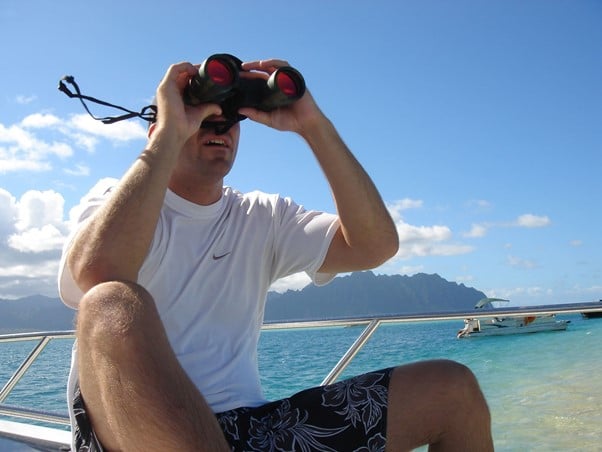
Fully coated means that the lenses’ outer and inner surfaces have multiple coated layers. This lens treatment provides the highest clarity, brightness, and light transmission levels.
Prism coatings, like lens coatings, help improve contrast, brightness, and light reflection. The best prism coating is the dielectric coatings that allow almost 100% light through the prism.
Phase correcting coating is another type of prism coating applied to roof prisms. Thanks to the roof prism design, the light splits into two beams that travel independently, hitting the eyepiece at different times.
When prism coating is applied, the faster beam is slowed down to match the slower one, resulting in improved clarity and contrast. Although this phase shift is hardly noticeable to beginners, phase correcting coating is vital to professional bird watchers.
Porro prisms don’t experience phase shifts; thus, they don’t require prism coatings.
The Glass Used
There are different types of glass used to manufacture binocular lenses and prisms.
For instance, generic optical glass at times has defects due to not being polished correctly, resulting in distorted images. However, low dispersion and extra-low dispersion glass transmit light better than generic glass with no distortion, resulting in sharper images with accurate color representation.
Some binoculars are made with ecologically friendly glass, which helps conserve the environment.
Our Top Recommendations of the Best Lightweight Travel Binoculars
The binoculars listed below have different designs and features unique to them and are best suited for various situations. That being said, here are our top picks for the best compact binoculars for travel.
Nikon Trailblazer ATB 10×25 Binocular — Best Overall
First on the list is the Nikon Trailblazer ATB 10X25 Binocular, as Nikon is a brand that is synonymous with high-quality products.
The compact binoculars measure less than 5 inches in length and weigh less than 10 ounces. They offer 10x magnification, an objective lens diameter of 25mm, and come with BaK-4 prism glass and Eco glass for high quality resolution.
They also have a close focus distance of 11.5 feet and a field of view of 342 feet at 1000 yards.
These roof prism compact binoculars provide an eye relief of 10mm, thus unsuitable for people with glasses. Since they are completely waterproof, they are ideal for outdoor use. The binocular design comprises a dual-hinge system meaning you can easily fold them when storing, taking up minimal space.
Pros:
- These lightweight and compact binoculars weigh less than 10 ounces.
- They are designed with BaK-4 prism glass and Eco glass.
- They provide a wide field of view, 342 feet at 1000 yards.
- They come with a harness for ease of storage on your person.
- They have a 10x magnification.
- They are completely waterproof.
Cons:
- The 10mm eye relief is unsuitable for users wearing glasses.
- They have sensitive eyepieces since the binoculars don’t have a way of locking the eyepieces in place.
Final Verdict
Nikon Trailblazer ATB 10×25 Binoculars will offer you high-quality images even under high magnification. The compact binoculars are also the best for your buck. They are most suitable for hunting, event observation, bird watching, and sightseeing.
Bushnell H20 8X25 Waterproof Roof Prism Binocular — First Runner’s Up
The Bushnell H20 8×25 binoculars are slightly under 5 inches in length and weigh slightly over 10 ounces. They have a rugged design that makes them durable for any weather.
These Bushnell binoculars have a magnification of 8x, objective lenses of 25 mm diameter, BaK-4 prisms, and multi-coated lenses, meaning that you’ll be able to see bright, high-resolution images. They also have an impressive field of view of 302 feet at 1000 yards.
These compact binoculars are wrapped around non-slip rubber armor that absorbs shock in case of a fall. They are also nitrogen-purged to provide a fog-free experience. However, they are not ideal for those who wear spectacles since they have 12mm eye relief, 2mm lower than the minimum recommended range.
Pros:
- The binoculars are relatively affordable ($100).
- The rubber armor makes them very durable.
- They are completely waterproof and fog proof, thus ideal for outdoor use.
- They have a relatively high magnification number of 8x.
- The large center focus knob is easy to adjust.
- They have multi-coated optics.
Cons:
- Compared to the other models in the list, they are considerably heavier.
- Not suitable for people wearing glasses.
Final Verdict
The Bushnell H2O 8×25 binoculars offer reliability and durability for a very reasonable price. Their design and waterproofing make them great for use during extreme weather. Due to their ruggedness, these compact binoculars are best suited for sightseeing, bird watching, and event watching.
Olympus WP II 8×25 Binocular — Best Viewing Experience
Our best pick on the list for viewing experience goes to Olympus WP II, one of the best binoculars in the market. Measuring at 4.5 inches in both length and width and weighing a little over 9 ounces, these compact binoculars are ideal for hiking, trekking, and boating.
They boast 8x magnification, 25 mm objective lens size, and fully multi-coated lenses with BaK4 prisms, resulting in bright, crisp images. The binoculars provide a conducive eye relief of 11.5mm (ideal for people wearing spectacles) and a field of view of 108m at 1000m.
These compact binoculars are also filled with nitrogen, making them waterproof, fog-proof, and dust-proof. The rubber coating finish on the exterior minimizes the chance of slippage during use, thus improving the binoculars’ durability.
Pros:
- These binoculars are dirt proof, fog proof, and waterproof.
- They boast an impressive eye relief of 15 mm.
- They have a large objective lens, 25 mm.
- They have fully multi-coated lenses.
- They are relatively lightweight.
Cons:
- They are fairly expensive.
Final Verdict
The heavy price tag attached justifies the high-quality features offered by the Olympus WP II compact binoculars. Thanks to the rubber casing, waterproof, fog-proof, and dust-proof design, these binoculars are best suited for travel and outdoor activities such as bird watching or hiking.
Nikon Aculon T02 Binoculars — Best for Portability
Nikon once again graces our list, this time becoming our pick for the best small binoculars for travel. These compact binoculars are 4 inches long and weigh an impressive 7 ounces, making them one of the best compact binoculars for travel.
The Nikon Aculon binoculars have a magnification strength of 8x, an optical lens size of 21mm, and a field of view of 330 ft at 1000 yards. They have multi-coated lenses, meaning they offer excellent image quality. Additionally, these small binoculars have an eye relief of 10mm, thus unsuitable for those who wear glasses.
Nikon Aculon T02 compact binocular design comprises a single hinge mechanism that allows for interpupillary adjustment, i.e., adjusting the distance between the user’s pupils and the binocular optics. They are also very stylish design, come in a wide range of colors to choose from, and are reasonably affordable.
Pros:
- They are pretty lightweight (7 ounces).
- They come with multi-coated lenses.
- Easy to operate with one hand.
- They allow for interpupillary adjustment.
- They provide a decent field of view of 330 ft at 1000 yards.
- They have a large focus wheel that’s also easy to use.
- Relatively affordable ($60 – $80).
- They provide 8x magnification power.
- They come in attractive, colorful designs.
Cons:
- They are not 100% waterproof.
- They have a single hinge that prevents them from folding for compact storage.
- The 10mm eye relief is not suitable for those with glasses.
- They are not suited for low light.
Final Verdict
The Nikon Aculon T02 8×21 binoculars come in a compact package that makes them portable for any occasion. Their fancy styling makes them suitable for bird watching or a night at the opera. However, they may not be for you if you require a pair with a higher magnification power.
Unfortunately, their lack of waterproofing makes them suitable for wet weather conditions.
Minox X-Lite 8×26 Binoculars for Outdoor Activities — Best Build Quality
From Germany comes the Minox, a company well-known for its work in spy cameras. Minox X-Lite8x26 binoculars measure 4.6 inches in length and weigh in at slightly over 10 ounces. This roof prism binocular has 8x magnification and an objective lens size of 26mm.
The binoculars are waterproof with an IPX7 rating and are nitrogen-purged to make them fog-proof. They are fully multicoated to provide crisp, clear images and have a 3.25 mm exit pupil diameter. They provide a field of view of 119 feet for 1000 yards and a 16mm eye relief which is great for those with glasses.
These compact binoculars are housed in protective armor to keep them safe from the elements. They also come with an objective lens cap, a neoprene carrying strap, and a carry case to further protect the binoculars.
Pros:
- They come with a protective casing, an objective lens cap, and other accessories to ensure their protection and durability.
- Provides adequate eye relief (16mm) for those with glasses.
- The lenses are fully multi-coated.
- Waterproof and fog-proof.
Cons:
- Pretty costly.
- They have a small field of view.
- They are relatively heavy.
Final Verdict
The Minox X-Lite 8×26 is a solid-built pair of binoculars that offers very high-quality images. Its sturdy design makes them ideal for activities such as nature viewing or hunting and their eye relief make them easy to use with glasses or shades on. However, they are somewhat heavy and expensive.
Frequently Asked Questions
How Good Are Compact Binoculars?
Due to their compact size and lightweight design, compact or pocket travel binoculars are made to be easy to use. Their magnification ranges from 3x to 12x, meaning that these binoculars are ideal for most things from watching a sports game on a large playing field to zooming in to see Madame Butterfly’s makeup on stage.
In the end, it narrows down to what you’d like to use them for.
What Else Should I Look for In Lightweight Travel Binoculars?
When shopping for the best lightweight travel binoculars, ruggedness and safety should also be high on your list. While no one imagines any intentional falls, it’s advisable to get binoculars with a non-slip casing and even a neck strap, if possible.
And if you’re attending the theatre on your travels, don’t forget to get a stylish pair, as most manufacturers have now incorporated colorful designs in their selections.
In Summary
Out of our list for the best compact binoculars recommended, the Nikon Trailblazer ATB 10×25 is the best of the bunch and takes the top spot. Their compact form and lightweight design make them an easy-to-carry accessory.
The binoculars’ objective lens diameter of 25 mm and multi-coated lenses provide crisp, bright pictures even in low light. The binoculars are also waterproof and filled with nitrogen to provide fog-free views.
Our first runner’s up is the Bushnell H20 8×25 Binoculars. These rugged, compact binoculars are best suited for the great outdoors. The device has a magnification of 8x and a wide field of view (302 feet at 1000 yards). They are also waterproof, fog proof, and reasonably affordable.
The third place goes to Olympus WP II 8×25, one of the best compact binocular for quality optics. They provide an 8x magnification and a wide field of view.





